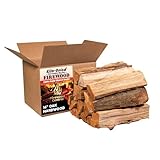Cottonwood is a popular choice for firewood due to its easy availability and low cost. However, to burn efficiently and produce optimal heat, it is important to properly season the wood. Seasoning refers to drying out the wood to reduce its moisture content. But how long to season cottonwood for firewood?
It generally takes 6 to 12 months to properly season cottonwood for firewood. Split cottonwood needs at least 6 months to season thoroughly. However, unsplit green cottonwood may require more time, up to 15 months.
In this blog post, we’ll take a closer look at the factors that influence the seasoning time for cottonwood and provide some tips on properly seasoning your cottonwood firewood.
What Is a Cottonwood Tree?
Cottonwood trees are fast-growing deciduous trees belonging to the Populus genus. These trees are native to North America and can be found near rivers, lakes, and other water sources.
Cottonwoods get their name from their cotton-like seeds, dispersed through the air during spring.
How Long to Season Cottonwood for Firewood?
It generally takes about 6 to 12 months to properly season cottonwood for firewood. The exact seasoning time can vary depending on the climate, humidity, and how the wood is stored. Split cottonwood needs at least 6 months to season thoroughly.
Once you’ve cut it into rounds, it may be safer and easier to split it after six months. Wet cottonwood is stringy; your ax could end up swallowed in the round rather than splitting it.
Importance: Seasoning firewood allows moisture to evaporate from the wood, reducing its water content to make it burn more efficiently. Properly seasoned firewood produces more heat, burns cleaner, and minimizes creosote buildup in your chimney or stove.
Best Time for Seasoning: The best season to use cottonwood as firewood is fall and spring when the weather is milder. Ensure the cottonwood is properly seasoned, with a moisture content below 20%, before using it as firewood.
BTU Rating: Seasoned Cottonwood has a BTU rating of approximately 16.8 million BTUs per cord.
Tips For Seasoning Cottonwood Firewood
To season cottonwood effectively, follow these steps:
- Start by splitting the cottonwood logs into smaller, more manageable pieces. This will increase the surface area, allowing the wood to dry more quickly and efficiently.
- Stack the split logs to allow for good airflow around each piece. This can be done by creating rows with gaps between the logs or using a log rack. Ensure that the stack is stable and not at risk of collapsing.
- To prevent the bottom logs from absorbing moisture from the ground, place cottonwood firewood on pallets or other supportive materials.
- Protect the top of the stack from rain and snow by covering it with a waterproof material such as a tarp. Ensure not to cover the entire stack, as this will limit airflow and slow the drying process.
- Choose a location for the stack that receives plenty of sunlight and has good air circulation. This will help to speed up the seasoning process.
- Check the moisture content of the wood regularly using a moisture meter. Ideally, the moisture content should be below 20% before burning. You may need to rotate the logs in the stack to ensure even drying.
- As mentioned earlier, seasoning cottonwood can take 6 to 12 months. Be patient and allow the wood to dry thoroughly before using it as firewood.

Testing Cottonwood for Dryness
To ensure your cottonwood firewood is adequately seasoned, you can perform the following tests:
- Visual inspection: Look for cracks at the ends of the logs, which indicate drying.
- Sound test: Knock two pieces of wood together; a hollow sound suggests dryness.
- Weight comparison: Dry wood feels significantly lighter than freshly-cut wood.
- Moisture meter: For a more precise measurement, use a moisture meter and aim for a 20% or lower moisture content.

Factors Influencing Cottonwood Seasoning Time
The length of time needed to season cottonwood firewood can vary depending on several factors:
- Wood species
- Size and shape of the wood pieces
- Climate and weather conditions
- Stacking and storage methods
Types of Cottonwood
There are several species of Cottonwood trees, some of which include:
- Eastern Cottonwood (Populus deltoides)
- Black Cottonwood (Populus trichocarpa)
- Fremont Cottonwood (Populus fremontii)
Pros and Cons of Cottonwood as Firewood
Pros
- Properly seasoned cottonwoods are easy to split
- Fast seasoning time
- Low-cost or free availability in certain areas
- Abundance and easy availability
- Quick seasoning due to low wood density
Cons
- Cottonwood fire has Lower BTU output compared to denser hardwoods
- Tendency to produce more creosote
- Burns quickly, requiring frequent reloading
- Green cottonwood smolders excessively

You May Also Like To Read:
How to Burn Cottonwood Safely.
When burning cottonwood in wood stoves, keep these safety tips in mind:
- Use a well-maintained, EPA-certified wood stove or fireplace insert for optimal efficiency.
- Burn only firewood that are seasoned properly to reduce creosote buildup and ensure efficient combustion.
- Maintain proper airflow by not overloading the stove or fireplace with too much wood at once.
- Regularly inspect and clean your chimney to prevent dangerous creosote accumulation.
- Always use a protective screen or glass door to keep embers from escaping and causing a fire hazard.
Alternatives to Cottonwood Firewood
If Cottonwood is not your ideal choice for firewood, consider these alternatives:
- Oak: I prefer oak because of its high BTU output and long burn time. It is an excellent option for firewood.
- Maple: Maple is dense hardwood that offers a high heat output and consistent burn.
- Birch: While it burns faster than oak or maple, birch still provides a good heat output and is easy to split.
- Ash: With its low moisture content, ash seasons quickly and burns cleanly, making it a popular choice for firewood.
The Environmental Impact of Using Firewood
Burning firewood can have both positive and negative environmental impacts. On the one hand, using firewood from sustainably managed forests can be a carbon-neutral source of heat, as new trees absorb the carbon dioxide released when burning wood.
However, burning firewood can also contribute to air pollution, especially when using improperly seasoned wood or outdated burning appliances.
To minimize the environmental impact of using firewood, consider these tips:
- Use only sustainably harvested wood from local sources.
- Burn only seasoned firewood for cleaner combustion.
- Upgrade to an EPA-certified wood stove or fireplace insert to improve efficiency and reduce emissions.

FAQs
Is Cottonwood Good Firewood?
Cottonwood is not the best option for indoor fires due to its low heat output, quick burn rate, and tendency to produce more smoke and creosote. However, it can still be utilized as supplementary firewood, mix cottonwood with other decent firewood choice.
What Does Cottonwood Smell Like?
Cottonwood has a relatively mild, slightly sweet smell when burned.
How Long Does Cottonwood Take to Season?
Cottonwood typically takes about 6 months to a year to properly season.
Does Cottonwood Smell?
Yes, Cottonwood has a mild, slightly sweet smell when burned.
Is Cottonwood Sap Messy?
Cottonwood sap can be sticky and messy, a nuisance during cutting and handling.
Does Cottonwood Burn Clean?
Cottonwood does not burn as cleanly as hardwoods, producing more creosote and smoke.
How Long Do You Season Cottonwood?
Cottonwood should be seasoned for 6 months to a year before burning.
How Does Cottonwood Compare to Other Types of Firewood?
Cottonwood is less efficient than hardwoods but is more readily available and seasons faster. It is best used as supplementary firewood or for outdoor fires.
Final Thoughts
How Long to Season Cottonwood for Firewood? Seasoning cottonwood for firewood typically takes between 6 to 9 months, making it a quicker option compared to denser hardwoods. By following proper seasoning techniques and safety precautions, cottonwood can be a viable firewood choice for those with easy access to this wood species.
However, it’s essential to consider the pros and cons of using cottonwood and weigh it against other available firewood options, taking into account factors such as heat output, burn time, and environmental impact.
Affiliate Disclosure: Fireplaceadviser.com is a participant in the Amazon Services LLC Associates Program. We may earn a commission when you click on certain links on this site and purchase.

Hello!! I am Jamal Khan. I often fix my home electric heaters and gas stove problems and research the common issues in the heating units to improve my knowledge and expertise. The aim of establishing fireplaceadviser.com is to share my expertise and knowledge with my audience.























